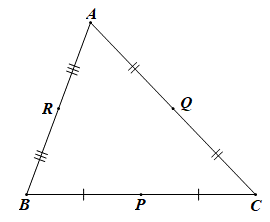Cho tam giác ABC. Gọi P, Q, R lần lượt là trung điểm của các cạnh BC, CA, AB. a) Xác định điểm N thỏa mãn vecto NA + vecto NB + 2 vecto NC = vecto 0 . b) Phân tích vecto AM theo vecto AB,
13
23/06/2024
Cho tam giác ABC. Gọi P, Q, R lần lượt là trung điểm của các cạnh BC, CA, AB.
a) Xác định điểm N thỏa mãn \(\overrightarrow {NA} + \overrightarrow {NB} + 2\overrightarrow {NC} = \overrightarrow 0 \).
b) Phân tích \(\overrightarrow {AM} \) theo \(\overrightarrow {AB} ,\overrightarrow {AC} \) với M ∈ BC thỏa mãn \(\overrightarrow {BM} = \frac{2}{5}\overrightarrow {BC} \).
c) Với điểm O bất kì, chứng minh \(\overrightarrow {OA} + \overrightarrow {OB} + 2\overrightarrow {OC} = 4\overrightarrow {ON} \).
Trả lời
Lời giải

a) Do R là trung điểm của AB nên \(\overrightarrow {NA} + \overrightarrow {NB} = 2\overrightarrow {N{\rm{R}}} \)
Ta có \(\overrightarrow {NA} + \overrightarrow {NB} + 2\overrightarrow {NC} = \overrightarrow 0 \)
\( \Leftrightarrow 2\overrightarrow {NR} + 2\overrightarrow {NC} = \overrightarrow 0 \)
\( \Leftrightarrow \overrightarrow {NR} + \overrightarrow {NC} = \overrightarrow 0 \)
Suy ra N là trung điểm của CR.
b) Ta có\(\overrightarrow {BM} = \frac{2}{5}\overrightarrow {BC} \)
\( \Leftrightarrow \overrightarrow {BA} + \overrightarrow {AM} = \frac{2}{5}\overrightarrow {BA} + \frac{2}{5}\overrightarrow {AC} \)
\( \Leftrightarrow \overrightarrow {AM} = \frac{2}{5}\overrightarrow {BA} + \frac{2}{5}\overrightarrow {AC} - \overrightarrow {BA} \)
\( \Leftrightarrow \overrightarrow {AM} = \frac{3}{5}\overrightarrow {AB} + \frac{2}{5}\overrightarrow {AC} \).
c) Ta có \(\overrightarrow {OA} + \overrightarrow {OB} + 2\overrightarrow {OC} = \overrightarrow {ON} + \overrightarrow {NA} + \overrightarrow {ON} + \overrightarrow {NB} + 2\overrightarrow {ON} + 2\overrightarrow {NC} \)
\( = 4\overrightarrow {ON} + \overrightarrow {NA} + + \overrightarrow {NB} + 2\overrightarrow {NC} = 4\overrightarrow {ON} \) (vì \(\overrightarrow {NA} + \overrightarrow {NB} + 2\overrightarrow {NC} = \overrightarrow 0 \))
Vậy \(\overrightarrow {OA} + \overrightarrow {OB} + 2\overrightarrow {OC} = 4\overrightarrow {ON} \).

